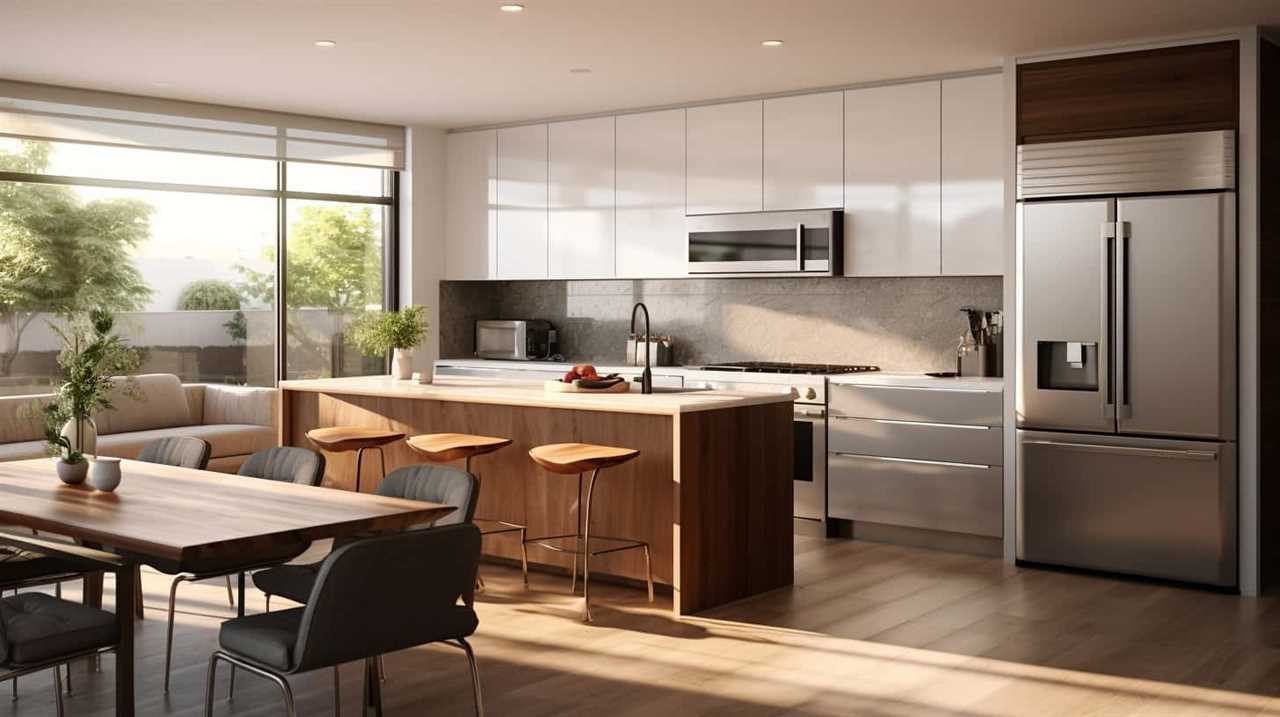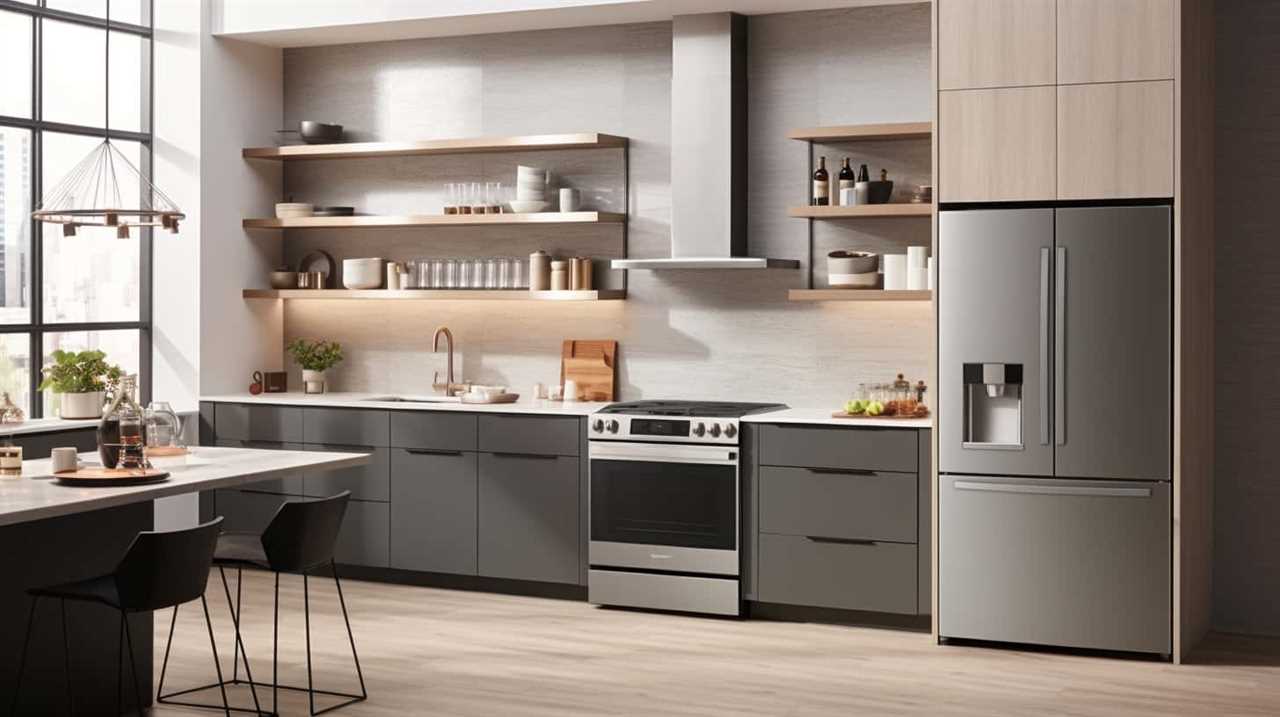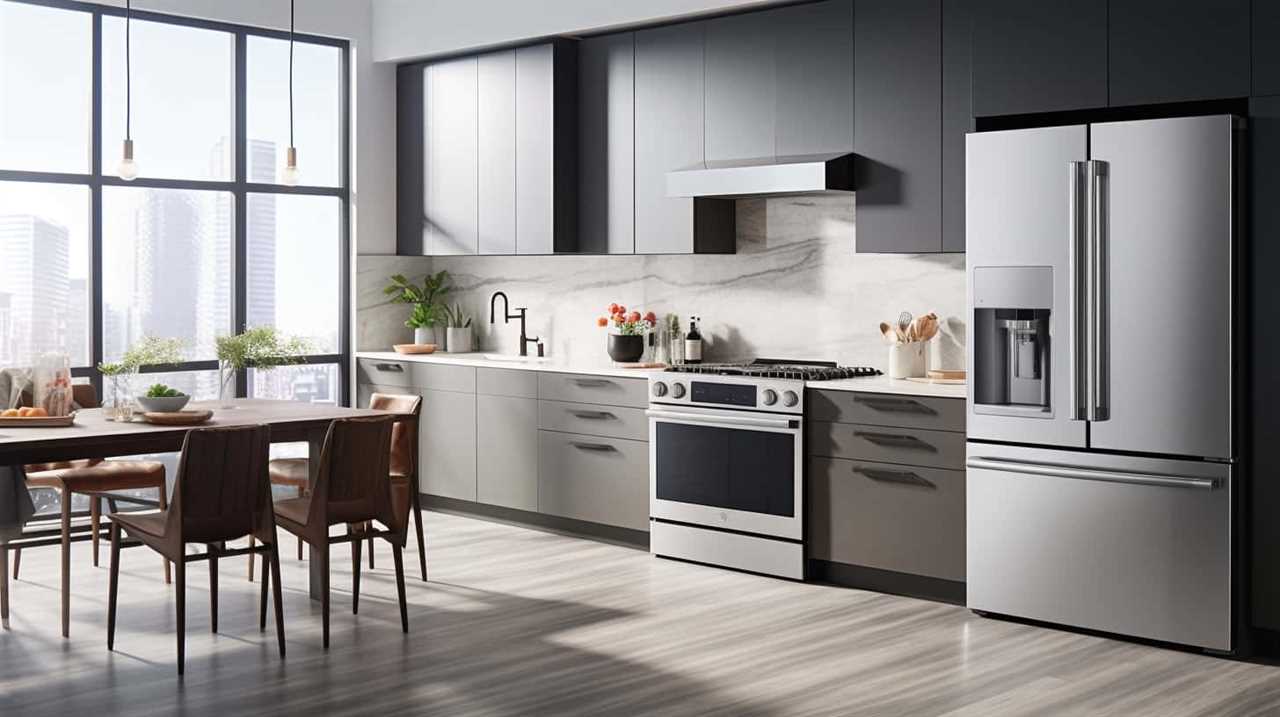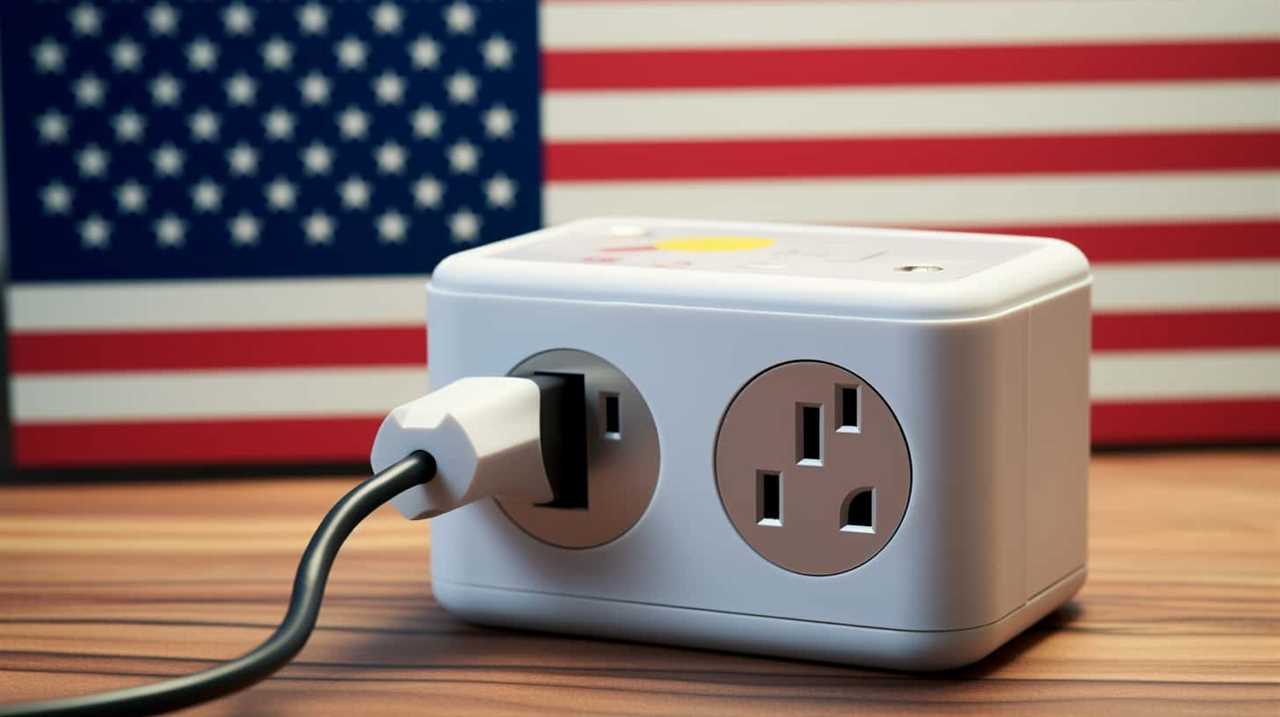Home appliances are necessary tools that make various household tasks easier, improving our daily lives with convenience and efficiency. These devices are created to carry out specific functions, simplifying and streamlining our chores.
From kitchen appliances, such as refrigerators and cooktops, to cleaning appliances like vacuum cleaners and washing machines, a wide range of home appliances cater to diverse needs. Heating and cooling appliances, such as air conditioners and heaters, ensure our homes remain comfortable throughout the year.
Laundry appliances, entertainment appliances, and other useful devices further contribute to a well-equipped and harmonious living space. Understanding the different types of home appliances and their uses empowers individuals to make informed decisions when selecting the most suitable options for their homes.
By harnessing the power of these modern tools, we can create a more productive and enjoyable living environment.

Key Takeaways
- Home appliances come in various types and cater to diverse needs, from kitchen appliances to cleaning appliances.
- Smart appliances offer convenient features such as scheduling and energy monitoring, while energy-efficient appliances consume less energy and reduce electricity bills.
- The market for home appliances is constantly evolving with more innovative and efficient options available.
- Kitchen appliances like refrigerators, stoves, and microwaves are essential, and there are also innovative cooking gadgets like induction cooktops and smart ovens.
Types of Home Appliances
There are various categories of home appliances available in the market.
One category that has gained popularity in recent years is smart appliances. These appliances are equipped with advanced technology that allows them to be controlled remotely via a smartphone or a voice assistant. Smart appliances offer convenient features such as scheduling, energy monitoring, and even automatic reordering of supplies.
Another category that has become increasingly important is energy-efficient appliances. These appliances are designed to consume less energy while still providing the same level of performance. They often come with features such as energy-saving modes, temperature control, and sensors that adjust settings based on usage. Energy-efficient appliances not only help reduce electricity bills but also contribute to a greener environment by reducing carbon emissions.
As technology continues to advance, we can expect to see more innovative and efficient home appliances in the market.

Kitchen Appliances
As we shift our focus to kitchen appliances, it is important to highlight the essential gadgets that every kitchen should have. These include appliances such as a refrigerator, stove, and microwave, which are fundamental for storing, cooking, and reheating food.
Additionally, it is worth mentioning the latest cooking innovations that have revolutionized the culinary world, such as induction cooktops, air fryers, and smart ovens, which offer advanced features and efficiency in the kitchen.
Essential Kitchen Gadgets
One must have essential kitchen gadgets in order to efficiently prepare meals. These smart kitchen gadgets are designed to simplify cooking tasks and save time in the kitchen. Here are three must-have cooking tools:
- Instant Pot: This multi-functional electric pressure cooker can be used as a slow cooker, rice cooker, yogurt maker, and more. It cooks food faster than traditional methods and retains nutrients, making it a versatile and convenient appliance for any kitchen.
- Food Processor: A food processor is an essential tool for chopping, slicing, and shredding ingredients quickly and efficiently. It saves time and effort in meal preparation and allows for consistent and precise cutting.
- Immersion Blender: This handheld blender is perfect for making soups, sauces, and smoothies. It is compact, easy to use, and eliminates the need for transferring hot liquids to a traditional blender.
Investing in these smart kitchen gadgets will greatly enhance your cooking experience and help you create delicious meals with ease. Now, let’s explore the latest cooking innovations.

Latest Cooking Innovations
In the realm of kitchen appliances, the latest cooking innovations are constantly pushing the boundaries of culinary convenience and efficiency. With the rise of smart cooking technology, the kitchen of the future is becoming a reality.
These futuristic kitchens are equipped with appliances that not only simplify the cooking process but also enhance the overall experience. One of the most notable advancements in cooking appliances is the integration of smart features. Smart ovens, for example, can be controlled remotely through a smartphone app, allowing users to preheat their ovens or adjust cooking settings even when they are not at home. This level of convenience allows for better time management and flexibility in meal preparation.
Additionally, there has been a surge in the development of multifunctional cooking appliances. These innovative devices combine several cooking methods into one, saving both space and time in the kitchen. Examples include combination microwave ovens that can bake, grill, and steam, as well as induction cooktops with built-in ventilation systems.
Another noteworthy advancement is the introduction of precision cooking technologies. Sous vide machines, for instance, allow for precise temperature control, resulting in perfectly cooked dishes every time. Similarly, induction cooktops utilize electromagnetic fields to heat cookware directly, offering faster and more efficient cooking.

Cleaning Appliances
When it comes to cleaning appliances, two common options are vacuums and mops.
While vacuums are effective at removing dirt and debris from carpets and hard floors, mops provide a more thorough cleaning by removing stains and disinfecting surfaces.
The choice between the two depends on the specific cleaning needs and preferences of the user.
Vacuum Vs. Mop
Comparing the functionality of vacuuming and mopping, both cleaning appliances serve distinct purposes in maintaining the cleanliness of a home. While vacuum cleaners are primarily designed to remove dust, dirt, and debris from carpets, rugs, and hard floors, steam mops are specifically designed to sanitize and disinfect surfaces using high-temperature steam.

Here are three key differences between vacuum cleaners and steam mops:
- Cleaning Mechanism: Vacuum cleaners use suction power to lift dirt and particles from surfaces, whereas steam mops use steam to loosen and dissolve dirt, which is then wiped away with a microfiber cloth.
- Surface Compatibility: Vacuum cleaners are suitable for a wide range of surfaces, including carpets, hardwood floors, and tile. On the other hand, steam mops are ideal for sealed hard floors, such as tile, vinyl, and laminate.
- Deep Cleaning: While vacuum cleaners effectively remove surface-level dirt, steam mops provide a deeper clean by killing bacteria and germs on the floor.
When considering the best cleaning methods for your home, it is essential to evaluate the specific needs of your surfaces and the type of dirt or grime you are dealing with.
Best Cleaning Methods?
With the variety of cleaning appliances available, it is important to consider the most effective methods for maintaining a clean and sanitary home. When it comes to choosing the best cleaning products, it is essential to opt for those that are effective yet environmentally friendly. Eco-friendly cleaning methods not only help to reduce the use of harmful chemicals but also minimize the impact on the environment.
One of the best cleaning methods is to use natural and non-toxic cleaning products, such as vinegar, baking soda, and lemon juice, which are effective in removing dirt and stains. Additionally, steam cleaning is an excellent option as it utilizes hot water vapor to sanitize and disinfect surfaces without the need for harsh chemicals.

Heating and Cooling Appliances
Heating and cooling appliances regulate indoor temperature for comfort and optimal living conditions. These appliances are essential for maintaining a pleasant atmosphere in homes and offices. Here are three types of heating and cooling appliances and their uses:
- Furnaces: Furnaces are heating appliances that use fuel combustion or electricity to generate heat. They distribute warm air through ducts and vents, providing a cozy environment during cold weather.
- Air conditioners: Air conditioners are cooling appliances that remove heat and humidity from indoor air. They use a refrigeration cycle to cool the air and maintain a comfortable temperature during hot summers.
- Heat pumps: Heat pumps are versatile appliances that can both heat and cool spaces. They transfer heat from one area to another, providing efficient heating in winter and cooling in summer.
Laundry Appliances
Laundry appliances are essential for efficiently and effectively cleaning and drying clothes. One of the key components of doing laundry is the use of laundry detergent. Laundry detergents are specially formulated to remove dirt, stains, and odors from clothing. They contain enzymes and surfactants that help break down and remove dirt particles. Additionally, dryer sheets are commonly used in laundry appliances to reduce static cling and add a fresh scent to the clothes. These sheets are coated with a thin layer of fabric softener that is released during the drying process. By incorporating laundry detergent and dryer sheets into the laundry routine, one can achieve clean, fresh-smelling clothes with minimal effort.
| Laundry Appliances | Uses |
|---|---|
| Washing machine | Cleaning clothes |
| Dryer | Drying clothes |
| Dryer sheets | Reducing static cling and adding fragrance |
Entertainment Appliances
Entertainment appliances, such as televisions and sound systems, provide enjoyment and relaxation for individuals and families. These devices have become an essential part of modern homes, offering various features and capabilities to enhance the entertainment experience.
Here are three popular entertainment appliances:

- Televisions: With advancements in technology, televisions now offer high-resolution displays, smart features, and access to streaming services. They serve as the centerpiece of home entertainment, providing a cinematic experience from the comfort of your living room.
- Home Theater Systems: To recreate the immersive audio experience of a movie theater, home theater systems include speakers, amplifiers, and receivers. They deliver surround sound, replicating the feeling of being in a cinema.
- Gaming Consoles: Gaming consoles, such as PlayStation and Xbox, offer a wide range of interactive entertainment. They allow users to play video games, stream content, and connect with friends online, providing a dynamic and engaging entertainment experience.
Other Useful Home Appliances
Refrigerators are an essential home appliance that plays a vital role in preserving food and keeping it fresh.
Aside from refrigerators, there are other home appliances that prove to be useful in maintaining a well-functioning household. One such appliance is the washing machine, which automates the process of cleaning clothes, saving time and effort.
Another essential appliance is the dishwasher, which simplifies the task of washing dishes and utensils, ensuring cleanliness and hygiene.
Additionally, the vacuum cleaner aids in maintaining a clean and dust-free environment, removing dirt and allergens from floors and carpets.

To ensure the longevity and optimal performance of these appliances, regular home appliance maintenance is crucial. This includes cleaning filters, checking for leaks or damages, and following manufacturer’s instructions for proper usage and care.
Frequently Asked Questions
Are Home Appliances Energy Efficient?
Home appliances can vary in terms of energy efficiency. Some appliances are designed with energy-saving features, such as low power consumption and smart technology, which help reduce energy consumption and promote energy efficiency.
How Do I Choose the Right Size of Home Appliances for My Space?
When choosing home appliances, it is crucial to consider the space requirements of your living area. Additionally, prioritize energy efficiency and safety precautions. Explore smart home integration options and eco-friendly alternatives for a well-rounded choice.
What Are Some Safety Precautions to Keep in Mind When Using Home Appliances?
When using home appliances, it is important to follow safety precautions to prevent electrical accidents. This includes regular appliance maintenance, such as checking cords for damage and keeping them away from water sources.

Can Home Appliances Be Connected to Smart Home Systems?
Integrating home appliances with smart home systems offers both benefits and drawbacks. While it enhances convenience and control, it also raises concerns about privacy and security. Additionally, connected appliances can contribute to energy efficiency by monitoring and optimizing energy consumption.
Are There Any Eco-Friendly Options Available for Home Appliances?
There are various eco-friendly options available for home appliances, including sustainable home technology. These appliances are designed to minimize energy consumption and reduce environmental impact, making them a responsible choice for environmentally-conscious consumers.
Conclusion
In conclusion, home appliances play a crucial role in our daily lives, providing convenience, efficiency, and comfort.
From kitchen appliances like refrigerators and ovens to cleaning appliances such as vacuum cleaners and washing machines, these devices help us save time and effort.

For instance, a case study demonstrated how the use of a smart thermostat resulted in a significant reduction in energy consumption, leading to cost savings and environmental benefits.
Overall, home appliances enhance our quality of life by simplifying household tasks and improving our overall living conditions.










